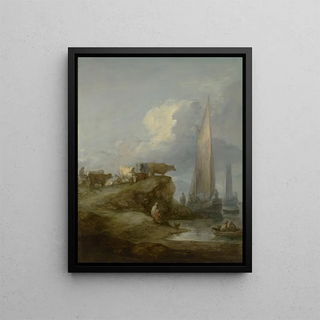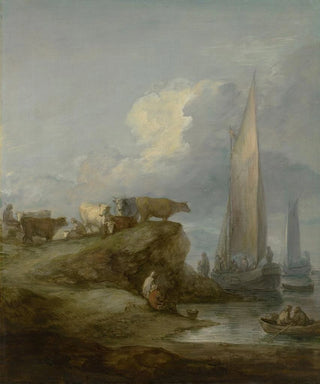Art print | Coastal scene with ships and livestock - Thomas Gainsborough


View from behind

Frame (optional)
Art print Coastal scene with ships and cattle - Thomas Gainsborough – Captivating introduction
In the rich and vibrant universe of 18th-century British art, the work "Coastal scene with ships and cattle" by Thomas Gainsborough stands out for its ability to capture the fleeting beauty of nature. This depiction of a maritime scene, where the sky meets the sea in a ballet of colors and lights, transports us to a world where tranquility reigns supreme. The ships, majestically anchored in the port, and the cattle peacefully scattered on the shore evoke harmony between man and his environment. This piece invites serene contemplation, where every detail is an invitation to explore the subtleties of coastal life.
Style and uniqueness of the work
Gainsborough, master of landscape painting, employs brush techniques that bring his painting to life. The texture of the clouds, the sparkle of the water, and the softness of the animal forms testify to his skill in playing with light and shadows. Each element of the composition, whether it be the white sails of the ships or the silhouettes of the cattle, is carefully arranged to create a scene of rare poetry. The color palette, dominated by pastel tones and shades of blue, evokes an atmosphere of calm and serenity, while the more vivid touches add a subtle dynamism to the overall. In sum, this work stands out for its elegance and its ability to evoke deep emotions, making each glance a unique experience.
The artist and his influence
Thomas Gainsborough, an iconic figure of the Rococo movement, knew how to mark his era with his innovative approach to painting. Born in 1727, he was initially influenced by the surrounding nature of his youth in Suffolk, which profoundly nourished his art. Gainsborough was also a pioneer in integrating landscapes into portraits, thus creating a new way to interpret the interaction between man and his environment. His influence is not limited to his time, as he paved the way for many artists who followed, particularly in exploring natural themes and romanticism. "Coastal scene with ships and cattle"

Matte finish

View from behind

Frame (optional)
Art print Coastal scene with ships and cattle - Thomas Gainsborough – Captivating introduction
In the rich and vibrant universe of 18th-century British art, the work "Coastal scene with ships and cattle" by Thomas Gainsborough stands out for its ability to capture the fleeting beauty of nature. This depiction of a maritime scene, where the sky meets the sea in a ballet of colors and lights, transports us to a world where tranquility reigns supreme. The ships, majestically anchored in the port, and the cattle peacefully scattered on the shore evoke harmony between man and his environment. This piece invites serene contemplation, where every detail is an invitation to explore the subtleties of coastal life.
Style and uniqueness of the work
Gainsborough, master of landscape painting, employs brush techniques that bring his painting to life. The texture of the clouds, the sparkle of the water, and the softness of the animal forms testify to his skill in playing with light and shadows. Each element of the composition, whether it be the white sails of the ships or the silhouettes of the cattle, is carefully arranged to create a scene of rare poetry. The color palette, dominated by pastel tones and shades of blue, evokes an atmosphere of calm and serenity, while the more vivid touches add a subtle dynamism to the overall. In sum, this work stands out for its elegance and its ability to evoke deep emotions, making each glance a unique experience.
The artist and his influence
Thomas Gainsborough, an iconic figure of the Rococo movement, knew how to mark his era with his innovative approach to painting. Born in 1727, he was initially influenced by the surrounding nature of his youth in Suffolk, which profoundly nourished his art. Gainsborough was also a pioneer in integrating landscapes into portraits, thus creating a new way to interpret the interaction between man and his environment. His influence is not limited to his time, as he paved the way for many artists who followed, particularly in exploring natural themes and romanticism. "Coastal scene with ships and cattle"






